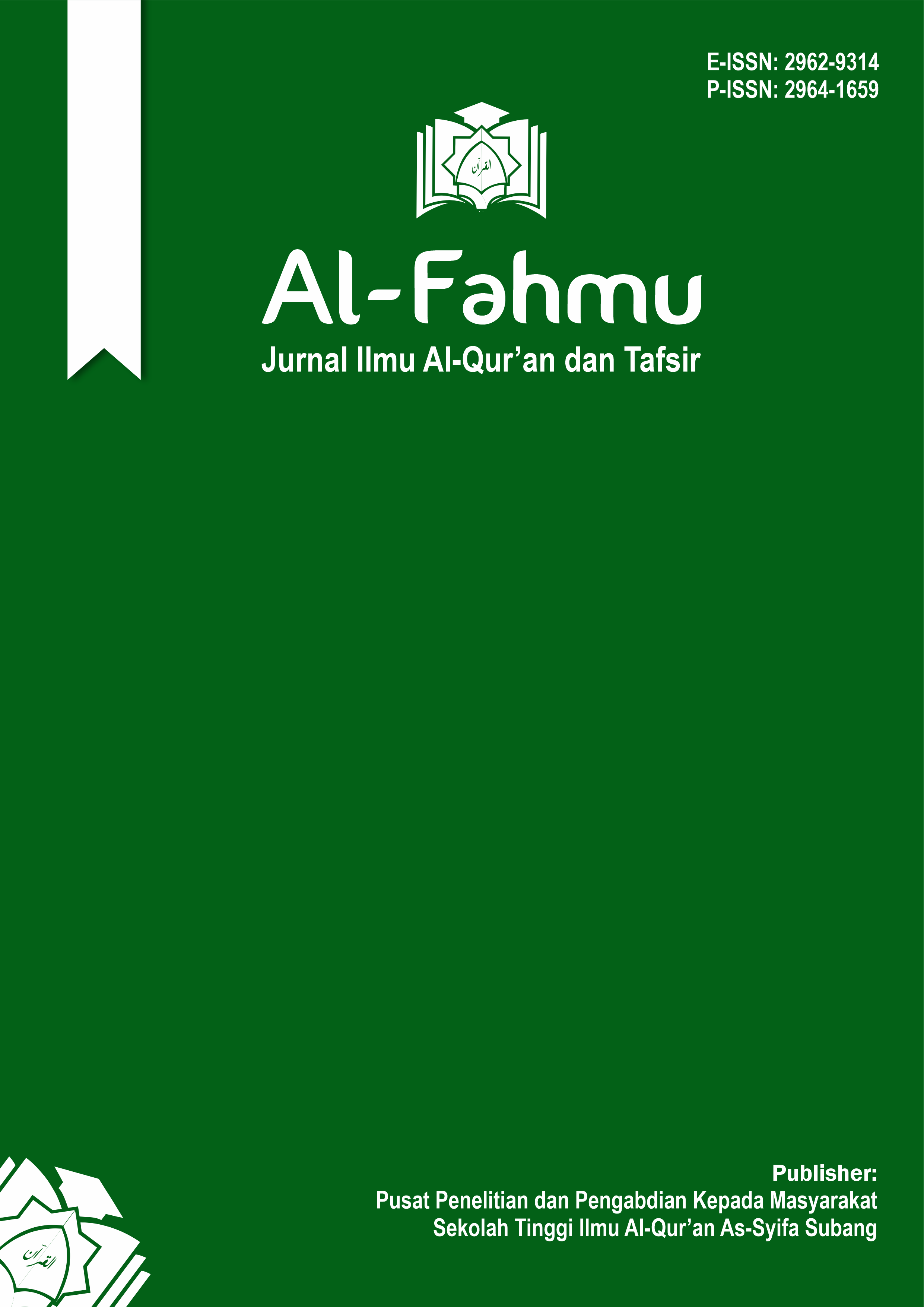Main Article Content
Abstract
The visualization of the houris in the Qur’an is described as hur ‘in, women with beautiful eyes and clear skin like hidden pearls. They are portrayed as shy, loyal, and eternally youthful. This imagery reflects the social construction of gender that influences classical interpretations, particularly in Tafsir Ath-Thabari. This study analyzes Ath-Thabari’s interpretation of the concept of houris in paradise and re-examines it through the lens of Judith Butler’s theory of gender as a social construct. Butler asserts that gender is not a fixed biological category but a social construct shaped by culture, language, and discourse. The interpretation of houris is not merely textual but also shaped by the patriarchal gender norms prevalent at the time the interpretation was formulated. This research employs a literature review method with a descriptive and linguistic analysis approach to the Qur’anic verses and Ath-Thabari’s exegesis. The findings reveal that Ath-Thabari interprets the houris literally, emphasizing their physical and sensual attributes as a form of pleasure for faithful men. The depiction of houris with large, beautiful eyes, ideal body shapes, and pure white skin reflects the classical Arab standards of beauty. From Butler’s perspective, such interpretations are cultural constructions that reproduce gender hierarchies, rather than representing absolute realities.
Keywords
Article Details

This work is licensed under a Creative Commons Attribution-NonCommercial-ShareAlike 4.0 International License.
References
- ‘Abd al-Baqi, M. F. (1996). Al-Mu‘Jam Al-Mufahras Li Alfaz Al-Qur’an Al-Karim. Dar al-Hadits.
- Al-Asfahani, A. R. (1997). Mufradat Alfaz al-Qur’an. Beirut: Dar al-Ma’rifah.
- Al-Fairuzabadi, M. (2005). Al-Qamus al-Muhit. Beirut: Dar al-Kutub al-‘Ilmiyyah.
- Al-Tabari, M. J. (2001). Jami’ al-Bayan fi Ta’wil al-Qur’an. Beirut: Dar al-Fikr.
- Ath-Tabari, I. J. (2007). Tafsir Jami' al-Bayan ‘an Ta’wil Ay al-Qur’an. Pustaka Azzam.
- Barlas, A. (2002). “Believing Women” in Islam: Unreading Patriarchal Interpretations of the Qur’an. University of Texas Press.
- Butler, J. (1988). Performative Acts and Gender Constitution: An Essay in Phenomenology and Feminist Theory. Theatre Journal, 40 (4), 519–531. https://doi.org/10.2307/3207893
- Butler, J. (1990). Gender Trouble: Feminism and the Subversion of Identity. Routledge. https://doi.org/10.4324/9780203824979
- Butler, J. (1999). Gender Trouble (2nd ed.). Routledge.
- Butler, J. (2004). Undoing Gender. Routledge. https://doi.org/10.9771/2317-1219rf.v0i19.5687
- Doctrine UK. (2023, Maret 14). Membaca Teori Gender Judith Butler: Tercipta Natural atau Bentuk Konstruksi Sosial? Doctrine UK. https://doctrineuk.org
- Hammer, J. (2012). The Qur’an and the Hermeneutics of Gender. Oxford University Press.
- Hassan, R. (1999). Feminist Theology: The Challenges for Muslim Women. In Y. Haddad & J. Esposito (Eds.), Islam, Gender, and Social Change (pp. 189–202). Oxford University Press.
- Inayah, Z. R., & Fauzi, A. M. (2024). Pembebasan Seksualitas dan Gender Dalam Film the Danish Girl: Studi Analisis Teori Performativitas Judith Butler. Paradigma, 13(1), 131–140.
- Ibn Manzur, M. (1990). Lisan al-‘Arab. Beirut: Dar Sadir.
- Jauhariyah, W. (2016, Maret 5). Gender dan Seks Dalam Konstruksi Sosial. Program Studi Islam dan Kajian Gender, Fakultas Ilmu-Ilmu Sosial, UIN Sunan Kalijaga.
- Ngangi, C. R. (2011). Konstruksi Sosial Dalam Realitas Sosial. Agri-Sosioekonomi, 7(2), 1–4. https://doi.org/10.35791/agrsosek.7.2.2011.85
- Nasr, S. H. (2002). The Heart of Islam: Enduring Values for Humanity. HarperSanFrancisco.
- Saidah, N. (2013). Bidadari dalam Konstruksi Tafsir Al-Qur’an: Analisis Gender atas Pemikiran Amina Wadud Muhsin dalam Penafsiran Al-Qur’an. Palastren: Jurnal Studi Gender, 6(2), 441–471. https://doi.org/10.19105/al-ihkam.v13i1.1467
- Salih, S. (2002). Judith Butler. Routledge.
- Tafsir Al-Qur’an. (2025, Februari 3). Ragam pemaknaan ayat-ayat tentang bidadari surga. Tafsir Al-Qur’an. [https://tafsiralquran.id/ragam-pemaknaan-ayat-ayat-tentang-bidadari-surga/](https://tafsiralquran.id/ragam-pemaknaan-ayat-ayat-tentang-bidadari-surga/)
- Tafsir Al-Qur’an. (2025, Februari 16). Lihat tafsir Ath-Thabari dalam tafsir Al-Qur’an terkait istilah ḥur ‘īn. Tafsir Al-Qur’an. [https://tafsiralquran.id/ragam-pemaknaan-ayat-ayat-tentang-bidadari-surga/](https://tafsiralquran.id/ragam-pemaknaan-ayat-ayat-tentang-bidadari-surga/)
- Umar, N. (1999). Argumen Kesetaraan Jender: Perspektif Al-Qur’an. Paramadina.
- Yusup, F. F. (n.d.). Penafsiran Makna ‘Azwāj Muṭahharah’ Dalam Al-Qur’an Perspektif Tafsir Al-Qurṭubī [Skripsi, Universitas Islam Negeri Syarif Hidayatullah Jakarta]. https://repository.uinjkt.ac.id/dspace/handle/123456789/51568
References
‘Abd al-Baqi, M. F. (1996). Al-Mu‘Jam Al-Mufahras Li Alfaz Al-Qur’an Al-Karim. Dar al-Hadits.
Al-Asfahani, A. R. (1997). Mufradat Alfaz al-Qur’an. Beirut: Dar al-Ma’rifah.
Al-Fairuzabadi, M. (2005). Al-Qamus al-Muhit. Beirut: Dar al-Kutub al-‘Ilmiyyah.
Al-Tabari, M. J. (2001). Jami’ al-Bayan fi Ta’wil al-Qur’an. Beirut: Dar al-Fikr.
Ath-Tabari, I. J. (2007). Tafsir Jami' al-Bayan ‘an Ta’wil Ay al-Qur’an. Pustaka Azzam.
Barlas, A. (2002). “Believing Women” in Islam: Unreading Patriarchal Interpretations of the Qur’an. University of Texas Press.
Butler, J. (1988). Performative Acts and Gender Constitution: An Essay in Phenomenology and Feminist Theory. Theatre Journal, 40 (4), 519–531. https://doi.org/10.2307/3207893
Butler, J. (1990). Gender Trouble: Feminism and the Subversion of Identity. Routledge. https://doi.org/10.4324/9780203824979
Butler, J. (1999). Gender Trouble (2nd ed.). Routledge.
Butler, J. (2004). Undoing Gender. Routledge. https://doi.org/10.9771/2317-1219rf.v0i19.5687
Doctrine UK. (2023, Maret 14). Membaca Teori Gender Judith Butler: Tercipta Natural atau Bentuk Konstruksi Sosial? Doctrine UK. https://doctrineuk.org
Hammer, J. (2012). The Qur’an and the Hermeneutics of Gender. Oxford University Press.
Hassan, R. (1999). Feminist Theology: The Challenges for Muslim Women. In Y. Haddad & J. Esposito (Eds.), Islam, Gender, and Social Change (pp. 189–202). Oxford University Press.
Inayah, Z. R., & Fauzi, A. M. (2024). Pembebasan Seksualitas dan Gender Dalam Film the Danish Girl: Studi Analisis Teori Performativitas Judith Butler. Paradigma, 13(1), 131–140.
Ibn Manzur, M. (1990). Lisan al-‘Arab. Beirut: Dar Sadir.
Jauhariyah, W. (2016, Maret 5). Gender dan Seks Dalam Konstruksi Sosial. Program Studi Islam dan Kajian Gender, Fakultas Ilmu-Ilmu Sosial, UIN Sunan Kalijaga.
Ngangi, C. R. (2011). Konstruksi Sosial Dalam Realitas Sosial. Agri-Sosioekonomi, 7(2), 1–4. https://doi.org/10.35791/agrsosek.7.2.2011.85
Nasr, S. H. (2002). The Heart of Islam: Enduring Values for Humanity. HarperSanFrancisco.
Saidah, N. (2013). Bidadari dalam Konstruksi Tafsir Al-Qur’an: Analisis Gender atas Pemikiran Amina Wadud Muhsin dalam Penafsiran Al-Qur’an. Palastren: Jurnal Studi Gender, 6(2), 441–471. https://doi.org/10.19105/al-ihkam.v13i1.1467
Salih, S. (2002). Judith Butler. Routledge.
Tafsir Al-Qur’an. (2025, Februari 3). Ragam pemaknaan ayat-ayat tentang bidadari surga. Tafsir Al-Qur’an. [https://tafsiralquran.id/ragam-pemaknaan-ayat-ayat-tentang-bidadari-surga/](https://tafsiralquran.id/ragam-pemaknaan-ayat-ayat-tentang-bidadari-surga/)
Tafsir Al-Qur’an. (2025, Februari 16). Lihat tafsir Ath-Thabari dalam tafsir Al-Qur’an terkait istilah ḥur ‘īn. Tafsir Al-Qur’an. [https://tafsiralquran.id/ragam-pemaknaan-ayat-ayat-tentang-bidadari-surga/](https://tafsiralquran.id/ragam-pemaknaan-ayat-ayat-tentang-bidadari-surga/)
Umar, N. (1999). Argumen Kesetaraan Jender: Perspektif Al-Qur’an. Paramadina.
Yusup, F. F. (n.d.). Penafsiran Makna ‘Azwāj Muṭahharah’ Dalam Al-Qur’an Perspektif Tafsir Al-Qurṭubī [Skripsi, Universitas Islam Negeri Syarif Hidayatullah Jakarta]. https://repository.uinjkt.ac.id/dspace/handle/123456789/51568
